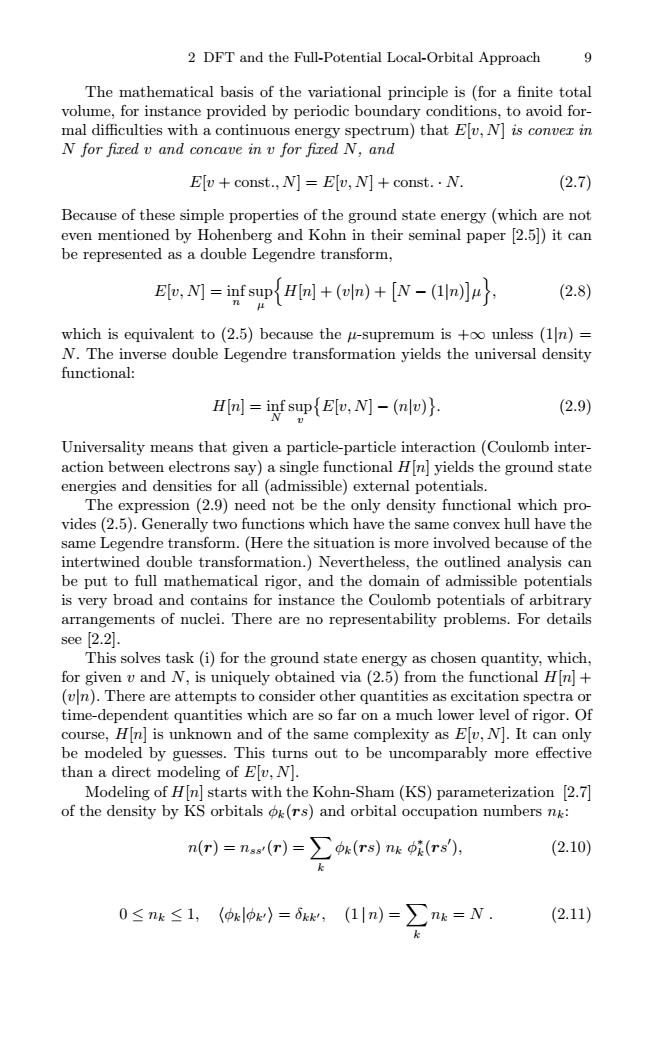正在加载图片...

2 DFT and the Full-Potential Local-Orbital Approach 9 The mathematical basis of the variational principle is (for a finite total volume,for instance provided by periodic boundary conditions,to avoid for- mal difficulties with a continuous energy spectrum)that Elv,N]is convex in N for fired v and concave in v for fired N,and E[v const.,N]E[v,N]+const..N. (2.7) Because of these simple properties of the ground state energy(which are not even mentioned by Hohenberg and Kohn in their seminal paper [2.5)it can be represented as a double Legendre transform, E[v,N]=inf sup]+(vln)+[N-(n)]u, (2.8) which is equivalent to (2.5)because the u-supremum is +oo unless (1n)= N.The inverse double Legendre transformation yields the universal density functional: H[n]inf sup{E[v,N]-(nlv). (2.9) Universality means that given a particle-particle interaction (Coulomb inter- action between electrons say)a single functional Hn]yields the ground state energies and densities for all (admissible)external potentials. The expression(2.9)need not be the only density functional which pro- vides(2.5).Generally two functions which have the same convex hull have the same Legendre transform.(Here the situation is more involved because of the intertwined double transformation.)Nevertheless,the outlined analysis can be put to full mathematical rigor,and the domain of admissible potentials is very broad and contains for instance the Coulomb potentials of arbitrary arrangements of nuclei.There are no representability problems.For details see[2.2. This solves task (i)for the ground state energy as chosen quantity,which, for given v and N,is uniquely obtained via (2.5)from the functional Hn+ (vn).There are attempts to consider other quantities as excitation spectra or time-dependent quantities which are so far on a much lower level of rigor.Of course,Hn]is unknown and of the same complexity as Elv,N].It can only be modeled by guesses.This turns out to be uncomparably more effective than a direct modeling of Elv,N]. Modeling of Hn]starts with the Kohn-Sham(KS)parameterization [2.7] of the density by KS orbitals ok(rs)and orbital occupation numbers nk: n(r)=ns(r)=∑(rs)nk(rs), (2.10) 0≤nk≤l,(〉=dk,(1|n)=nk=N, (2.11)2 DFT and the Full-Potential Local-Orbital Approach 9 The mathematical basis of the variational principle is (for a finite total volume, for instance provided by periodic boundary conditions, to avoid formal difficulties with a continuous energy spectrum) that E[v,N] is convex in N for fixed v and concave in v for fixed N, and E[v + const., N] = E[v,N] + const. · N. (2.7) Because of these simple properties of the ground state energy (which are not even mentioned by Hohenberg and Kohn in their seminal paper [2.5]) it can be represented as a double Legendre transform, E[v,N] = inf n sup µ H[n]+(v|n) + N − (1|n)
µ
, (2.8) which is equivalent to (2.5) because the µ-supremum is +∞ unless (1|n) = N. The inverse double Legendre transformation yields the universal density functional: H[n] = inf N sup v E[v,N] − (n|v) . (2.9) Universality means that given a particle-particle interaction (Coulomb interaction between electrons say) a single functional H[n] yields the ground state energies and densities for all (admissible) external potentials. The expression (2.9) need not be the only density functional which provides (2.5). Generally two functions which have the same convex hull have the same Legendre transform. (Here the situation is more involved because of the intertwined double transformation.) Nevertheless, the outlined analysis can be put to full mathematical rigor, and the domain of admissible potentials is very broad and contains for instance the Coulomb potentials of arbitrary arrangements of nuclei. There are no representability problems. For details see [2.2]. This solves task (i) for the ground state energy as chosen quantity, which, for given v and N, is uniquely obtained via (2.5) from the functional H[n] + (v|n). There are attempts to consider other quantities as excitation spectra or time-dependent quantities which are so far on a much lower level of rigor. Of course, H[n] is unknown and of the same complexity as E[v,N]. It can only be modeled by guesses. This turns out to be uncomparably more effective than a direct modeling of E[v,N]. Modeling of H[n] starts with the Kohn-Sham (KS) parameterization [2.7] of the density by KS orbitals φk(rs) and orbital occupation numbers nk: n(r) = nss (r) = k φk(rs) nk φ∗ k(rs ), (2.10) 0 ≤ nk ≤ 1, φk|φk = δkk , (1 | n) = k nk = N . (2.11)��